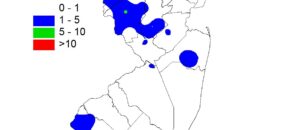For over a decade, basil downy mildew (BDM) has caused significant losses in basil grown in organic and conventional field and greenhouse production across the United States. At the time of its introduction, there were very few fungicides labeled for its control making it nearly impossible to grow a successful crop in many areas of […]
Continue reading...Grasshopper damage increasing in soybeans and corn

Differential grasshopper populations are heavily feeding on corn, soybeans and unharvested grass fields and waterways in Salem County. Damage is being observed above economic threshold in mutiple fields across the county where the broods are congregating. Reports from producers indicate the brood population was not this bad in 2020 and may be an indication this […]
Continue reading...Vegetable IPM Update 08/11/21

Sweet Corn European corn borer (ECB) moths have been captured at more locations over the past week, but numbers remain very low, and feeding has rarely risen to detectable levels. ECB population maps will resume if second flight catches rise to high enough numbers. The highest nightly blacklight trap catches of ECB for the week […]
Continue reading...Fruit IPM for 8/11/21
Brown Rot: Brown rot pressure remains very high. Make sure to alternate fungicide chemistries or FRAC groups. See page 179 of the Tree Fruit Production Guide for the most effective products and Table 7.7 on page 154 for a summary of fungicide efficacy and FRAC groupings reprinted below:
Continue reading...Sun Exposure and Skin Cancer Precautions in Agriculture

We all want to be healthy and it is important to take measures to prevent illness and injuries. Everyone, especially farmers need to be cautious about their exposure to the ultraviolet rays (UV) of the sun. Skin cancer is the most common type of cancer in the United States and is related to repeated exposure […]
Continue reading...Be Aware of Heat Stress and Weather-Related Injury
As temperature and humidity rise during the summer months of the growing season, it is important to prepare yourself and your employees to prevent heat related injuries. Here are some tips:Train Employees: Train employees on how to identify possible heat stress symptoms and how to prevent or treat them.Adjust Work Schedule: • Monitor temperature and […]
Continue reading...